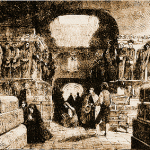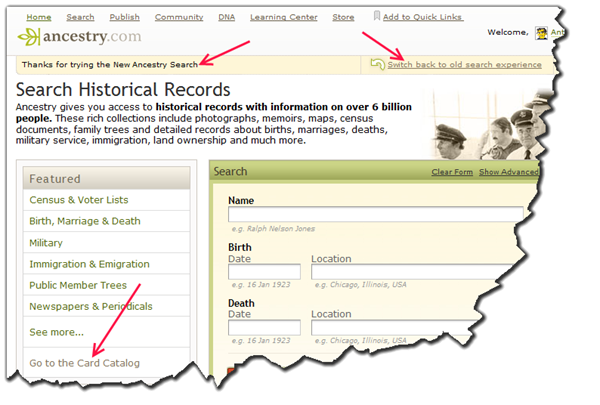Search results
Free Genealogy Search: 1940 US Census Returns Go Live April 12, 2012
October 12, 2011 by ramona
Filed under Articles, Latest News, Public Records
 A visit to the National Archives genealogy resources page evokes a subtle sense of excitement, as the counter ticks down to the April 2, 2012 release of the 1940 US census returns. These important records will be accessible through public access computers at Nara facilities on a national level. They can also be conveniently accessed through the internet from your personal computer. Better yet, it is free of charge. The 1940 census is the 16th Federal Population Census of the United States and the census day was April 1.
A visit to the National Archives genealogy resources page evokes a subtle sense of excitement, as the counter ticks down to the April 2, 2012 release of the 1940 US census returns. These important records will be accessible through public access computers at Nara facilities on a national level. They can also be conveniently accessed through the internet from your personal computer. Better yet, it is free of charge. The 1940 census is the 16th Federal Population Census of the United States and the census day was April 1.
The questionnaire for this census was a double-sided form that afforded space for 40 entries. There were also two additional lines for the five percent sample questions.
New questions added
Many of the questions answered on the 1940 returns are customary to census questionnaires. However there are several new questions added that are likely to provide clues of great value to your genealogy research. For instance, the 1940 census asks for the name of the person providing the information as well as the birthplace of that person’s mother and father.
Some other interesting questions asked on the 1940 census include:
• Whether the home of the enumerator is owned or rented, as well as the value of the home
• Whether there are any persons currently absent from the household
• Highest completed level of education
• It asks for a specific profession such as salesman, music teacher or laborer etc
• Whether the person is a veteran of the US military or the wife, widow or child of a veteran
• The earliest language spoken at home during childhood
Of a woman’s marital status it asks for the number of times a woman has been married, her age at the time of her first marriage and the total number of children born to her. (Excluding stillbirths)
Research strategies
For those of you who are already eagerly anticipating your research of the 1940 returns. Here are a few strategies to help you get the most out of your investigation. At the top of this list is the knowledge that you will not be able to conduct searches by name, as there will be no name index available when it first opens up. To locate your ancestor, you are going to need their address as well as the enumeration district in which it was located. It may be a good idea to start gathering some of this data now.
In order to find the addresses of the forebear(s) you will be researching. You can start looking them up in city directories. These directories are usually available in your local library, so initiate your inquiry there. If you have already found your predecessors in the 1930 census, use it as a starting point for your 1940 census searches. Another excellent resource for tracking down locations is the WWII draft records.Should you still be having trouble locating the enumeration districts you need? Try the 1940 enumeration district, census maps, as they should contain the district numbers.
It is important to note, that maps may not be available for all towns; in this case, looking at county maps is the next step.
Links to enumeration district finding aids:
• Geographic Descriptions of Census Enumeration Districts
• Enumeration District Maps
• 1940 City Directories at NARA
• Use Stephen P. Morse’s Search engines to locate Census Enumeration District Numbers
This information should get you off to a great start. However, should you want a little more assistance there is a very informative guide available at the NARA Website. Before you leave, grab the table for deciphering the codes used in the 1940 census. Print it out and keep it with your preparation materials for an organized search later. This will give you plenty to do while waiting for April 2, 2012 to arrive.
For more information on this and other great genealogy resources visit: National Archives and Records Administration.
50 Best Blogs for Genealogy Geeks by Online University
May 20, 2010 by Chris
Filed under Articles, Genealogy for Beginners, Latest News
 Genealogy Beginner was rated within the top 50 Best Blogs for Genealogy Geeks online by Online University. We’re proud to share the spotlight with some great fellow genealogy bloggers. You can check out the full list at Online University. They break the list up into four key sections: General, Specific Research Projects, Libraries and Resources, News.
Genealogy Beginner was rated within the top 50 Best Blogs for Genealogy Geeks online by Online University. We’re proud to share the spotlight with some great fellow genealogy bloggers. You can check out the full list at Online University. They break the list up into four key sections: General, Specific Research Projects, Libraries and Resources, News.
The number one blog for each category included:
- General – DearMYRTLE’s Genealogy Blog: Myrtle helps those looking to piece together their family histories learn about the genealogy process.
- Specific Research Projects – AnceStories: The Stories of My Ancestors: Follow this blogger’s journey to learn how to go about your own research project.
- Libraries and Resources – Ancestry.com Blog: Ancestry.com keeps readers and site users updated on genealogy and online research.
- News – GenealogyBlog: This is a daily news blog for genealogy enthusiasts, which outlines special events, collections, research tips, and more.
Thanks again to the great people doing good work over at Online University. We appreciate the mention.
Ancestry.com’s Card Catalogs
Ancestry.com’s Card Catalogs are a fantastic resource for helping all of you genealogists and family history buffs locate documents for your generations past. Sorting through the immense amount of information available is a task that can be extremely overwhelming. The card catalogue will help simplify the process; it will let you search in the same way your local libraries’ card catalogue does.

You can search by:
Name,
Location
Keyword
If you have any troubles don’t worry; The Ancestry Insider has done it again with another enormously helpful article; this one is a fantastic “How-To” post about Ancestry.com’s Card Catalogs.
Complete with excellent screen shots, this short but sweet step by step guide walks you through both the new and old catalogue search functions and will have you searching like a pro in no time.
Old Search

New Search
Notice: The Ancestry Insider is independent of Ancestry.com and FamilySearch.org. The opinions expressed herein are his own. Trademarks used herein are trademarks or registered trademarks of their respective owners. The name Ancestry Insider designates the author’s status as an insider among those searching their ancestry and does not refer to Ancestry.com. All content is copyrighted unless designated otherwise.
(Notice and images from The Ancestry Insider.)
Facebook for the Dead?
September 11, 2008 by Chris
Filed under Articles, Cemetery Searches, Genealogy Cemetery Searches, Genealogy Records 101
A press release from  explains how, and why, Footnote.com takes social networking into the past. When a loved one is lost, friends and family members experience a range of emotions from sorrow and grief to comfort. Often, this leads to sharing stories and memories. Until now, it has been a challenge to find a place where these stories can come together to easily be shared, preserved and enriched. At Footnote.com, anyone can create or find Footnote Pages, a space where users can connect and share information, photos and stories about people important to them.
explains how, and why, Footnote.com takes social networking into the past. When a loved one is lost, friends and family members experience a range of emotions from sorrow and grief to comfort. Often, this leads to sharing stories and memories. Until now, it has been a challenge to find a place where these stories can come together to easily be shared, preserved and enriched. At Footnote.com, anyone can create or find Footnote Pages, a space where users can connect and share information, photos and stories about people important to them.
To celebrate the new Footnote Pages, Footnote.com created over 80 million pages from the data in the SSDI. These pages feature an interactive timeline, map, photo gallery, and many other tools which has led some to refer to Footnote Pages as the Facebook for the Deceased.
Read the full press release at the Footnote Press Room, or visit the Footnote Blog.
…
Where to Next?
…
Searching Cemetery Monument Foundations
February 9, 2008 by Chris
Filed under Articles, Cemetery Searches, Genealogy Cemetery Searches, Genealogy Records 101
 This book will intrigue anyone involved in serious genealogical research, posing a whole new way to uncover family roots and facts through research into cemeteries and their contents. This book has all kinds of great information from funeral art to conducting cemetery surveys. The author, Sharon Debartolo Carmack, covers how to access and interpret death certificates, obituaries, coroner’s records, wills, memorial and prayer cards, funeral home records, and mortality schedules. She also outlines the process of locating individual graves and elusive cemteries.
This book will intrigue anyone involved in serious genealogical research, posing a whole new way to uncover family roots and facts through research into cemeteries and their contents. This book has all kinds of great information from funeral art to conducting cemetery surveys. The author, Sharon Debartolo Carmack, covers how to access and interpret death certificates, obituaries, coroner’s records, wills, memorial and prayer cards, funeral home records, and mortality schedules. She also outlines the process of locating individual graves and elusive cemteries.
You can read more about this guide on Amazon.com:
Your Guide to Cemetery Research
…
Where to Next?
…

